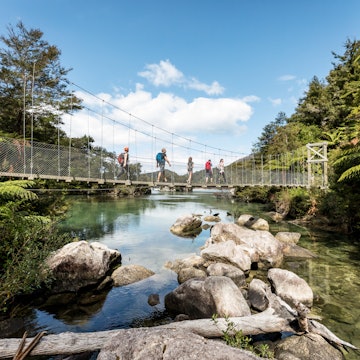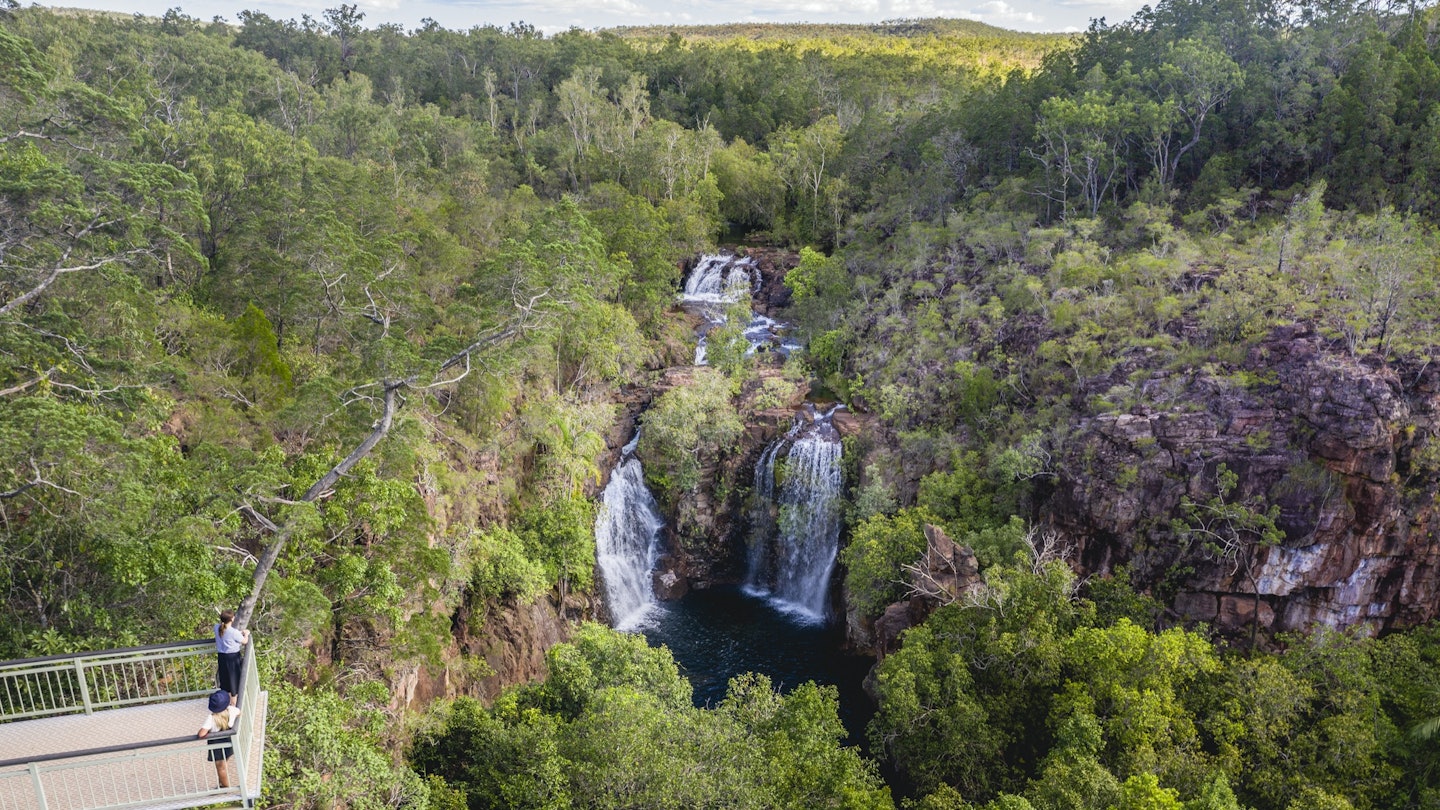
Aug 5, 202212 min read
15 epic hikes in Australia and New Zealand among volcanoes, rainforests and moreSponsored by
May 21, 2021 • 5 min read

Visitors view Florence Falls from the lookout at Litchfield National Park © Rob Mulally / Tourism Northern Territory
Australia’s Northern Territory is vast, with a range of environments and climate. In the tropical Top End, there are two major seasons, the Dry (roughly April to September) and the Tropical Summer (October to March), while down south the Red Centre experiences a temperate four-season cycle. Whatever the season, there is always a place to find a panoramic view, a unique experience, a refreshing swim, or an invigorating hike. Before taking a plunge anywhere in the Northern Territory wilds, always seek advice from parks staff and heed all signage.

Just a two-hour drive from Darwin, Litchfield National Park’s dramatic sandstone geology sets the scene for some of Northern Territory’s most scenic swimming spots, pleasant hikes and fascinating ecology.
Water is the star of Litchfield – it falls from the sky, percolates through sandstone fissures, and falls again over ancient fault lines into deep, clear plunge pools. Depending on water flows, swimming at Litchfield is possible year-round and designated, croc-free swimming areas are accessed by road (Buley Rockhole, Florence Falls, Wangi Falls, Cascades and Walker Creek), 4WD track (Tjaynera Falls and Surprise Creek Falls), or short walk (Greenant Creek Walk).
Several Darwin-based tour companies visit Litchfield as a day trip. For the best experience, take a small-group tour, such as Ethical Adventures, with the flexibility to avoid the peak crowds and the permits necessary to access little-visited water holes.
Some waterfalls are better looked at than swum under. Check out Tolmer Falls, one of Litchfield’s most spectacular cascades, especially in the Wet, with a pleasant walk through swaying native hibiscus to the viewing platform. Wangi Falls plunges into a huge fish-filled swimming hole, but here swimming is restricted to the Dry season.
You can also look forward to exploring brand new areas of the national park soon, with new recreational swimming areas and campsites - Litchfield’s Central Valley - opening in 2021.

Kakadu National Park is also a year-round destination, but the seasons will dictate where and how you can spend your visit. The northern section of Kakadu comes into its own as a hiking and swimming destination in the Dry. The largest waterfall in the park, Jim Jim Falls, all but dries up, but the pool beneath is a magnet for adventurers equipped with a 4WD and prepared to tackle a 1.2-mile return hike if needed.
Come the Wet season, the falls are a ferocious torrent and access along the floodplain is blocked. This is when scenic flights from Jabiru are at their best. Kakadu Air have several daily flights – try to get a seat on the sunset flight, when the escarpment glows in the warm evening light, shadows delineate the stone landscapes and the waterfalls (particularly Jim Jim Falls) are simply stunning.
The spectacular rock art sites at Ubirr and Burrungkuy (Nourlangie Rock) are open throughout the year with all-season paved roads for access. Several short hikes along well-marked trails in the northern section of the park are always open in the Dry and sometimes partially open in the Wet.
Longer hikes with trail markers but not formed trails, such as the Barrk Sandstone Bushwalk at Burrungkuy, explore exposed stone terrain and should only be attempted by experienced walkers carrying sufficient water and supplies. Overnight walks require a special permit from the Bowali Visitor Information Centre.

In southern Kakadu head to Motor Car Falls and Boulder Creek – both are short-walk destinations in Yurmikmik country, are great for swimming, and are accessible all year. You may need a 4WD during the Wet to get to the trail heads. Swimming is best here in the early months of the year, between January - April, though be alert for sudden water level rises. A pair of goggles will reveal a tropical underwater landscape teeming with an aquarium-level variety of fish.
Wondering why it’s called Motor Car Falls? In 1946 an intrepid tin miner went ‘off-road’ in a trusty Chevrolet truck. He didn’t get far, stopped by the boulder-strewn creek and falls that now bear this memorable name.
In the Dry, other swimming options open in the south. An exquisite pool surrounded by rocky ledges lies below Maguk Falls, and a chain of pools above the falls is just waiting to be explored. Impressive Gunlom Falls is accessible by 2WD on an unsealed road and offers a large plunge pool below the falls.

Nitmiluk National Park, about 19 miles from Katherine, is one of the Northern Territory’s must-see destinations. The park’s headline feature is the series of 13 deep gorges carved by the Katherine River. In the Wet, the enormous power of the river is a sight to behold by boat. If you’re headed there between June – October, the gorge is buzzing with recreational activities.
The region’s famous river cruises operate year-round, but the program will vary depending on water levels. In addition to cruising through the awesome gorge, the park has around 75 miles of trails, from short walks to multiday hikes. Another great option to appreciate the grandness of the gorges is from a helicopter.
Most hikes in Nitmiluk start from the park HQ, the Nitmiluk Centre, and climb above the gorge. Hikes are available year-round, though walkers must always be prepared for hot conditions and carry plenty of water. Nitmiluk’s famous Jatbula Trail is a five-day walk toward Leliyen (Edith Falls). It’s open from May to September, with rock art and swimming opportunities at the end of each day in perfectly positioned campsites.
Finally, wrap up your Nitmiluk National Park tour under your own steam – by canoe. Boats can be rented at the Nitmiluk Centre and you will be transported to the second gorge, where the adventure begins. If you’re prepared to portage your canoe between gorges, the reward is solitude amongst a wealth of humbling scenery. Gecko Canoeing & Trekking offers a range of multi-day, fully guided canoe safaris on the Katherine River.
Four ways Australia’s Northern Territory will surprise you
How to experience Australia’s Northern Territory sustainably and ethically
As a travel entertainment and inspirational media outlet, we sometimes incorporate brand sponsors into our efforts. This activity is clearly labeled across our platforms.
This story was crafted collaboratively between Australia's Northern Territory and Lonely Planet. Both parties provided research and curated content to produce this story. We disclose when information isn’t ours.
With sponsored content, both Lonely Planet and our brand partners have specific responsibilities:
Determines the concept, provides briefing, research material, and may provide feedback.
We provide expertise, firsthand insights, and verify with third-party sources when needed.